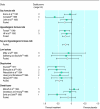Effectiveness of treatments for infantile colic: systematic review
- PMID: 9596593
- PMCID: PMC28556
- DOI: 10.1136/bmj.316.7144.1563
Effectiveness of treatments for infantile colic: systematic review
Erratum in
- BMJ 1998 Jul 18;317(7152):171
Abstract
Objective: To evaluate the effectiveness of diets, drug treatment, and behavioural interventions on infantile colic in trials with crying or the presence of colic as the primary outcome measure.
Data sources: Controlled clinical trials identified by a highly sensitive search strategy in Medline (1966-96), Embase (1986-95), and the Cochrane Controlled Trials Register, in combination with reference checking for further relevant publications. Keywords were crying and colic.
Study selection: Two independent assessors selected controlled trials with interventions lasting at least 3 days that included infants younger than 6 months who cried excessively.
Data synthesis: Methodological quality was assessed by two assessors independently with a quality assessment scale (range 0-5). Effect sizes were calculated as percentage success. Effect sizes of trials using identical interventions were pooled using a random effects model.
Results: 27 controlled trials were identified. Elimination of cows' milk protein was effective when substituted by hypoallergenic formula milks (effect size 0.22 (95% confidence interval 0.09 to 0.34)). The effectiveness of substitution by soy formula milks was unclear when only trials of good methodological quality were considered. The benefit of eliminating cows' milk protein was not restricted to highly selected populations. Dicyclomine was effective (effect size 0.46 (0.33 to 0.60)), but serious side effects have been reported. The advice to reduce stimulation was beneficial (effect size 0.48 (0.23 to 0.74)), whereas the advice to increase carrying and holding seemed not to reduce crying. No benefit was shown for simethicone. Uncertainty remained about the effectiveness of low lactose formula milks.
Conclusions: Infantile colic should preferably be treated by advising carers to reduce stimulation and with a one week trial of a hypoallergenic formula milk.
Figures
Comment in
-
Effectiveness of treatments for infantile colic. Dietary interventions in breast fed and bottle fed infants should not be pooled.BMJ. 1998 Nov 21;317(7170):1451; author reply 1452. BMJ. 1998. PMID: 9822411 Free PMC article. No abstract available.
-
Effectiveness of treatments for infantile colic. Findings apply only to the most severely affected infants.BMJ. 1998 Nov 21;317(7170):1451; author reply 1452. BMJ. 1998. PMID: 9882115 No abstract available.
-
Effectiveness of treatments for infantile colic. Trial of hypoallergenic milk is not supported by strong enough evidence.BMJ. 1998 Nov 21;317(7170):1451-2. BMJ. 1998. PMID: 10232901 No abstract available.
References
-
- Wessel MA, Cobb JC, Jackson EB, Harris GS, Detwiler AC. Paroxysmal fussing in infancy, sometimes called “colic.”. Pediatrics. 1954;14:421–434. - PubMed
-
- Barr RG. Colic and gas. In: Walker WA, Durie PR, Hamilton JR, editors. Pediatric gastrointestinal disease: pathophysiology, diagnosis and management. Philadelphia: Decker; 1991. pp. 55–61.
-
- Miller AR, Barr RG. Infantile colic. Is it a gut issue? Pediatr Clin North Am. 1991;38:1407–1423. - PubMed
Publication types
MeSH terms
Substances
LinkOut - more resources
Full Text Sources

